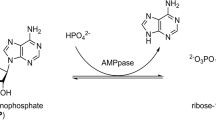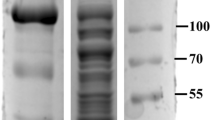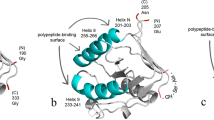Abstract
Fusion proteins of monomeric α-glucosidase from Saccharomyces cerevisiae containing N- or C-terminal hexa-arginine peptides were expressed in the cytosol of Escherichia coli in soluble form. The polycationic peptide moieties allow noncovalent binding of the denatured fusion proteins to a polyanionic solid support. Upon removal of the denaturant, refolding of the matrix-bound protein can proceed without perturbation by aggregation. However, nonspecific interactions of the denatured polypeptide, or of folding intermediates, with the matrix cause a drastic decrease in renaturation under suboptimal folding conditions. At low salt concentrations, ionic interactions of the refolding polypeptide with the matrix result in lower yields of renaturation. At higher salt concentrations, renaturation is prevented by hydrophobic interactions with the matrix. Apart from ionic strength, renaturation of the denatured matrix-bound fusion protein must be optimized with respect to pH, temperature, cosolvents, and matrix material used. Under optimum conditions, immobilized α-glucosidase can be renatured with a high yield at protein concentrations up to 5 mg/ml, whereas folding of the wild-type enzyme in solution is feasible only at an extremely low protein concentration (15 μg/ml). Thus, folding of the immobilized α-glucosidase allows an extremely high yield of the renaturated model protein. The technology should be applicable to other proteins that tend to aggregate during refolding.
This is a preview of subscription content, access via your institution
Access options
Subscribe to this journal
Receive 12 print issues and online access
$209.00 per year
only $17.42 per issue
Buy this article
- Purchase on Springer Link
- Instant access to full article PDF
Prices may be subject to local taxes which are calculated during checkout
Similar content being viewed by others
References
Marston, F.A.O. 1986. The purification of eukaryotic polypeptides synthesized in Escherichia coli. Biochemistry J. 240: 1–12
Rudolph, R. 1990 Renaturation of recombinant, disulfide-bonded proteins from “inclusion bodies,” p. 149–171 in Modern Methods in Protein and Nucleic Acid Research. H. Tschesche (ed), Walter de Gruyter, Berlin, New York.
Rudolph, R. 1996. Successful protein folding on an industrial scale, in Principles & Practice of Protein Engineering, J. L. Cleland & C. S. Craik (eds), J. Wiley & Sons, Inc., New York In press.
Kiefhaber, T., Rudolph, R., Kohler, H.-H. and Buchner, J. 1991. Protein aggregation in vitro and in vivo: A quantitative model of the kinetic competition between folding and aggregation. Bio/Technology 9: 825–829.
Höll-Neugebauer, B., Rudolph, R., Schmidt, M. and Buchner, J. 1991. Reconstitute of a heat shock effect in vitro Influence of GroE on the thermal aggregation of α-glucosidase from yeast. Biochemistry 30: 11609–11614.
Goldberg, M.E., Rudolph, R. and Jaemcke, R. 1991. A kinetic study of the competition between renaturation and aggregation during the refolding of denatured-reduced egg white lysozyme. Biochemistry 30: 2790–2797.
Golubinoff, P., Christeller, J.T., Gatenby, A.A. and Lorimer, G.H. 1989. Reconstitute of active dimeric ribulose bisphosphate carboxylase from an unfolded state depends on two chaperonm proteins and Mg-ATP. Nature 342: 884–889.
Buchner, J., Schmidt, M., Fuchs, M., Jaenicke, R., Rudolph, R., Schmid, F.X. and Kiefhaber, T. 1991. GroE facilitates refolding of citrate synthase by suppressing aggregation. Biochemistry 30: 1586–1591.
Freeman, R.B. 1992. Protein folding in the cell, p. 455–539 in Protein Folding. T. E. Creighton (ed.), W. H. Freeman and Company, New York.
Hendrick, R.W. and Hartl, F.U. 1993. Molecular chaperone function of heat shock proteins. Ann. Rev. Biochemistry 62: 349–384.
Jaenicke, R. and Rudolph, R. 1989. Folding proteins, p. 191–223 in Protein Structure A Practical Approach. T. E. Creighton (ed.), IRL Press, Oxford, New York, Tokyo.
Epstein, C.J. and Anfinsen, C.B. 1962. The reversible reduction of disulfide bonds in trypsin and ribonuclease coupled to carboxymethyl cellulose. J. Biol. Chem. 237: 2175–2179.
Mozhaev, V.V., Martinek, K. and Berezin, I.V. 1979. Effect of immobilization on folding of protein (trypsin). Mol. Biol. 13: 52–57.
Sinha, N.K. and Light, A. 1975. Refolding of reduced, denatured trypsinogen and trypsin immobilized on agarose beads. J. Biol. Chem. 250: 8624–8629.
Creighton, T.E. 1985. Folding of proteins adsorbed reversibly to ion-exchange resins, p. 249–258 in UCLA Symposia on molecular and cellular biology new senes, Vol. 39 Oxender, D. L. (ed.).
Geng, X. and Chang, X. 1992. High-performance hydrophobic interaction chromatography as a tool for protein refolding. J. Chromatography 599: 185–194.
Sinha, D., Bakhshi, M. and Vora, R. 1994. Ligand binding assays with recombinant proteins refolded on an affinity matrix. BioTechniques 17: 509–514.
Ahmed, A.K., Schaffer, S.W. and Wetlaufer, D.B. 1975. Nonenzymic reactivation of reduced bovine pancreatic ribonuclease by air oxidation and by glutathione oxidoreduction buffers. J. Biol. Chem. 250: 8477–8482.
Seckler, R. and Jaenicke, R. 1992. Protein folding and protein refolding. FASEB J. 6: 2545–2552.
Stempfer, G. 1995. Dissertation. University of Regensburg.
Walker, P.A., Leong, L.E.-C., Ng, P.W. P., Han Tan, S., Waller, S., Murphy, D. and Porter, A.G. 1994. Efficient and rapid affinity purification of proteins using recombinant fusion proteases. Bio/Technology. 12: 601–605.
Nygren, P.-A., Stahl, S. and Uhlén, M. 1994. Engineering proteins to facilitate bioprocessing. Tibtech 12: 184–188.
Sambrook, J.L., Fritsch, E.F. and Maniatis, T. 1989. Molecular Cloning A Laboratory Manual, 2nd ed Cold Spring Harbor Laboratory Press, Cold Spring Harbor, N. Y.
Kopetzki, E., Schumacher, G. and Buckel, P. 1989. Control of formation of active soluble or inactive insoluble baker's yeast α-glucosidase PI in Escherichia coli by induction and growth conditions. Mol. Gen. Genet. 216: 149–155.
Bradford, M.M. 1976. A rapid and sensitive method for the quantitation of microgram quantities of protein utilization the principle of protein dye-binding. Anal. Biochemistry 72: 248–254.
Author information
Authors and Affiliations
Rights and permissions
About this article
Cite this article
Stempfer, G., Höll-Neugebauer, B. & Rudolph, R. Improved Refolding of an Immobilized Fusion Protein. Nat Biotechnol 14, 329–334 (1996). https://doi.org/10.1038/nbt0396-329
Received:
Accepted:
Issue Date:
DOI: https://doi.org/10.1038/nbt0396-329
This article is cited by
-
Refolding with Simultaneous Purification of Recombinant Serratia marcescens Lipase by One-Step Ultrasonication Process
Applied Biochemistry and Biotechnology (2020)
-
Alumina nanoparticle-assisted enzyme refolding: A versatile methodology for proteins renaturation
Scientific Reports (2017)
-
Molecular Cloning and Characterization of a (Lys)6-Tagged Sulfide-Reactive Hemoglobin I from Lucina pectinata
Molecular Biotechnology (2015)
-
Engineering and refolding of a novel trimeric fusion protein TRAIL-collagen XVIII NC1
Applied Microbiology and Biotechnology (2013)
-
Production and on-column re-folding of human vascular endothelial growth factor 165 in Escherichia coli
Biotechnology and Bioprocess Engineering (2013)



